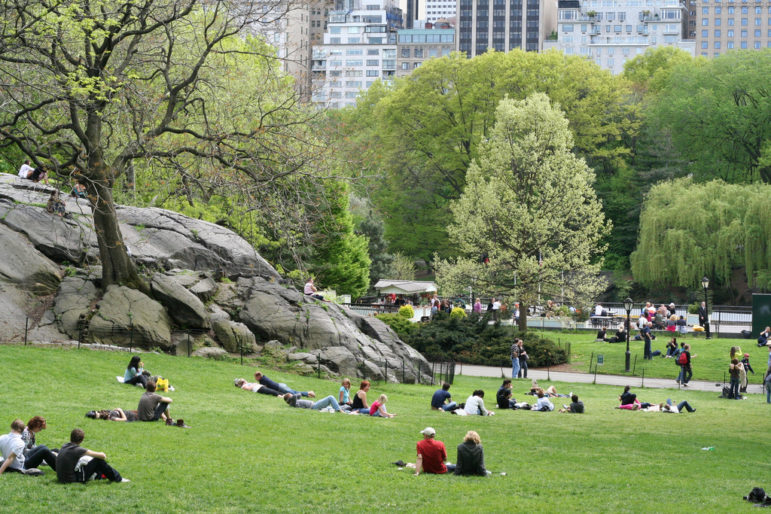
Dan Cipolla
Park as refuge. Park as tonic.
This is how we feel in New York and in cities around the world as the coronavirus pandemic rages. When crowded streets, churches, concert halls, and restaurants harbor germs that could kill us, we offer hosannas for our parks. When fresh air and sunshine seem like our only salvation, we flock to our open-air urban green spaces—spaces that are available to all, regardless of income or social standing.
This is why Mayor de Blasio must not cut funding to the Parks Department or to the non-profit groups that help keep our parks clean and green. Many observers fear such cuts at this moment of pandemic-induced fiscal worry and after the recent warning by Brett Meaney, the Parks Department’s director of contracts, to his agency’s non-profit partners to freeze their spending of discretionary Fiscal Year 2020 funds received from the City. With federal and state governments increasing funding to fight coronavirus, NYC must also invest in the urban oases that are helping New Yorkers cope.
It’s no accident that Frederick Law Olmsted, the chief genius behind the design of Central Park, Prospect Park, and other magnificent city parks, dubbed these urban oases “lungs for the city.” Olmsted understood what immense benefits—physical and emotional—open spaces confer when dense populations confront public-health crises or go about their daily lives in normal times.
Writing in “The Highest Value of a Park” in 1882, Olmsted summed up the generally accepted 19th Century view: “The current of public opinion thus established is still so strong that scientific sanitarians are often carried off their feet by it. I have a pamphlet prepared by an eminent physician, not ten years ago, in which the project of a park, now being formed at great cost, is advocated solely with reference to the value of its air…It being desired that people should benefit by the sanitary advantage of breathing, even for one or two hours a week, the air of the parks, it is reasonable and economical to beguile them into doing so by making the parks attractive. Hence, besides building roads and walks and supplying shade, seats and opportunities of refreshment, large sums may be wisely expended in the planting of trees, and the introduction of other objects purely with decorative motives.”
 CityViews are readers’ opinions, not those of City Limits. Add your voice today!
CityViews are readers’ opinions, not those of City Limits. Add your voice today!
New York City boasts 1,700 parks, playgrounds, and recreation sites. These include ponds, waterfalls, brooks, meadows, lawns, woodlands, wetlands, flower beds, skating rinks, swimming pools, basketball courts, bandshells, and more. Pelham Bay Park in the Bronx is the city’s largest, at 2,765 acres. Central Park alone has more than 26,000 trees. Maintaining this bounty costs the “large sums” Olmsted mentioned. But these substantial investments generate substantial returns: An analysis done several years ago estimated that in Fiscal Year 2014, “New York City tax and fee revenues attributable to the operations of the [Central Park] Conservancy and other Central Park-based enterprises, to spending by out-of-town visitors to the Park, and to the increase in property values associated with proximity to the Park, totaled more than $1.045 billion.”
In these scary days of coronavirus, Central Park and the other green spaces in our city refresh and reassure us; even though we need to stay six feet apart due to social-distancing, the parks beckon. So as we seek renewal and tranquility there—and as we anticipate the post-pandemic era when the city will need to rebuild its economy—let’s urge the mayor not to cut funds to support our parks. Invest in parks instead. Green spaces—as well as the greenbacks they generate—matter.
Eileen Monreale, author of Mathilde Weingartner: A Staten Island Naturalist, is president of Friends of Olmsted-Beil House, a non-profit organization that seeks to preserve and present to the public Frederick Law Olmsted’s 19th Century farmhouse on Staten Island. Emily F. Mandelstam, a former journalist, is a volunteer at the organization.









2 thoughts on “Opinion: Don’t Puncture the City’s Lungs By Cutting Park Funds”
Absolutely agree! Many are far removed from nature! Our health, as a species, depends on our connection to nature. For me nature is a destressor. It is a vital part of my mental health! ❤️🌳
We must keep our parks open without our parks were else we go most of us just cant to public land as we like it so our local parks is the next best things.